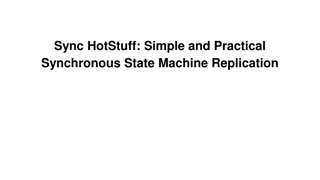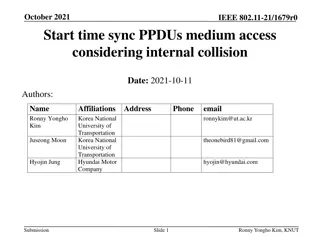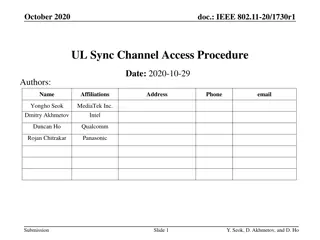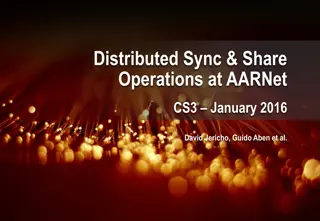
Synchronization Techniques in Shared Memory Systems
Explore synchronization techniques in shared memory systems, including fork-join synchronization, readers-writers problem, and multiple readers scenarios. Understand the challenges and solutions for ensuring data consistency and efficiency in parallel processing.
Uploaded on | 0 Views
Download Presentation

Please find below an Image/Link to download the presentation.
The content on the website is provided AS IS for your information and personal use only. It may not be sold, licensed, or shared on other websites without obtaining consent from the author. If you encounter any issues during the download, it is possible that the publisher has removed the file from their server.
You are allowed to download the files provided on this website for personal or commercial use, subject to the condition that they are used lawfully. All files are the property of their respective owners.
The content on the website is provided AS IS for your information and personal use only. It may not be sold, licensed, or shared on other websites without obtaining consent from the author.
E N D
Presentation Transcript
Synchronization with shared memory AMANO, Hideharu Textbook pp.60-68
Fork-join: Starting and finishing parallel processes fork Usually, these processes (threads) can share variables fork Fork/Join is a way of synchronization However, frequent fork/joins degrade performance Operating Systems manage them join join These processes communicate with each other Synchronization is required !
Synchronization An independent process runs on each PU (Processing Unit) in a multiprocessor. When is the data updated? Data sending/receiving (readers-writers problems) A PU must be selected from multiple PUs. Mutual exclusion All PUs wait for each other Barrier synchronization Synchronization
Readers-Writers Problem Writer Reader D Polling until(X==1) Write(D Data) Write(X,1) X Writer writes data then sets the synchronization flag Reader waits until flag is set
Readers-Writers Problem Writer Reader Polling until(X==0) Polling until(X==1) data Read(D) Write(X 0) X Reader reads data from D when flag is set, then resets the flag Writer waits for the reset of the flag
Readers-Writers Problem Writer Reader Polling until(X==0) Then write other data 0 X Reader reads data from D when flag is set, then resets the flag Writer waits for reset of the flag
But is it true? In most machines, the order of read/write access from/to different address is not guaranteed. The order is kept when each processor uses the sequential consistency or the total store ordering (TSO). This will be treated later.
Multiple Readers Writer Reader D Write(D Data) Write(c 3) c Writer writes data into D, then writes 3 into c. Reader Polling until( c!=0 ) (Each reader reads data once.)
Multiple Readers Iterative execution Polling until(c!=0) data = Read(D); counter = Read(c) Write(c counter-1) Polling until(c==0); Writer Polling until(c==0) Reader Reader: decrements c Writer waits until c==0 There is a problem!!
The case of No Problem Shared data An example of correct operation PU counter=Read(c) Write(c counter-1) counter=Read(c) Write(c counter-1)
The Problematic Case An example of incorrect operation Multiple PUs may get the same number (2) The value never changes to 0
Indivisible (atomic) operation The counter is a competitive variable for multiple PUs A write/read to/from such a competitive variable must be protected inside the critical section. A section which is executed by only one process. For protection, an indivisible operation which executes continuous read/write operations is required.
An example of an atomic operation Test and Set Polling until (Test & Set(X)==0) Write X 0 =Test&Set(X) Reads x and if 0 then writes 1 indivisibly.
Various atomic operations Swap(x,y): exchanges shared variable x with local variable y Compare & Swap (x,b.y): compares shared variable x and constant b, and exchanges according to the result. And-write/Or-write: reads bit-map on the shared memory and writes with bit operation. Fetch & *(x,y): general indivisible operation Fetch & Dec(x): reads x and decrements (if x is 0 do nothing). Fetch&Add(x): reads x and adds y Fetch&Write1: Test & set Fetch&And/Or:And-write/Or-write Most of them are used in RISC-V/A as atomic memory operations
An example using Fetch&Dec Writer Polling until(c==0) Reader = (c) Polling until(c==0)
Load ReservedLocked)/Store Conditional Using a pair of instructions to make an atomic action. lr Load Reserved): Load Instruction with Lock. sc (Store Conditional): If the contents of the memory location specified by the load reserved are changed before sc to the same address (or context switching occurs), it fails and returns 0. Otherwise, returns 1. Atomic Exchange using lr/sc (x4<-> Memory indicated by x1) try: mov x3,x4 lr x2,0(x1) sc x3,0(x1) beqz x3,try mov x4,x2 RISC-V/A mainly uses them for synchronization.
The benefit of lr/sc Locking bus system is not needed. Easy for implementation lr: saves the memory address in the link register sc: checks it before storing the data Invalidated with writing the data in the same address like the snoop cache.
Implementing lr and sc PE1 PE2 lr x2,0(x1) lr x2,0(x1) R1=0x1000 R1=0x1000 Data in 1000 is read out. Link register 1000 1000 Memory Cache is omitted in this diagram
Implementing lr and sc PE2 executes sc first PE1 PE2 sc x3,0(x1) 1 is returned to x3 R1=0x1000 x1=0x1000 PE Link register - 1000 R3 Snoop and Invalidate Memory
Implementing lr and sc Then, PE1 executes sc PE1 PE2 R1=0x1000 sc x3,0(x1) 0 is returned to x3 PE Link register - - x3 X The data is not written Snoop and Invalidate Memory
Quiz Implement Fetch and Decrement by using lr and sc.
Answer try: lr x2,0(x1) addi x3,x2,#-1 sc x3,0(x1) beqz x3,try If sc is successful, the memory was decremented without interference.
Multi-Writers/Readers Problem Mutual exclusion Writer 3 Reader 0 = (c) Polling until(c==0) Selects a writer from multiple writers 1 Writer-Multi Readers
Glossary 1 Synchronization: Mutual exclusion: ( Indivisible(atomic) operation: ( Critical Section: ( Fork/Join: Barrier Synchronization: Readers-writers problem Producer-Consumer Problem
Implementation of a synchronization operation Bus mastership is locked between Read/Write operation Main Memory Write 1 A large bandwidth shared bus Read 0 Snoop Cache Snoop Cache Snoop Cache 1 (DE) Modify Test & Set 0 PU PU PU PU
Snoop Cache and Synchronization Main Memory A large bandwidth shared bus Test & Set Test & Set Snoop Cache Snoop Cache 1 (DE) CS 1(CS) 0 PU PU PU PU Even for the line with CS, Test & Set requires Bus transaction
TestTestSet Test&Set c if c == 0 Main Memory A large bandwidth shared bus Snoop Cache Snoop Cache Test 0 1 1 Test&Set Test Polling for CS line PU PU PU PU Test does not require bus, except the first trial DE does not require bus transaction
TestTestSet Test&Set c if c == 0 Main Memory A large bandwidth shared bus Invalidation signal Snoop Cache Snoop Cache 0 1 - 1 0 PU PU PU PU Cache line is invalidated Release critical section by writing 0
TestTestSet Test&Set c if c == 0 Main Memory A large bandwidth shared bus Write back Snoop Cache Snoop Cache 0 - 0 PU PU PU PU Test Release critical section by writing 0
TestTestSet Test&Set c if c == 0 Main Memory Test & Set A large bandwidth shared bus Snoop Cache Snoop Cache 0- 0 PU PU PU PU Test & Set is really executed If other PU issues the request, only a PU is selected.
Lock with lr/sc lockit: lr x2,0(x1) ; load reserved x2,lockit ; not-available spin addi x2,x0,#1 ; locked value sc x2,0(x1) ; store beqz x2,lockit ; branch if store fails bnez Since the bus traffic is not caused by lr instruction, the same effect as test-test-and set can be achieved.
Semaphore High level synchronization mechanism in the operating system A sender (or active process) executes V(s) (signal), while a receiver (or passive process) executes P(s) (wait). P(s) waits for s = 1 and s 0 indivisibly. V(s) waits for s = 0 and s 1 indivisibly. Busy waiting or blocking Binary semaphore or counting semaphore
Monitor High level synchronization mechanism used in operating systems. A set of shared variables and operations to handle them. Only a process can execute the operation to handle shared variables. Synchronization is done by the Signal/Wait.
Synchronization memory Memory provides tag or some synchronization mechanism Full/Empty Memory with Counters - /
A data cannot read from 0 A data can write into 1 Suitable for 1-to-1 communication
Memory with counters A data cannot read from 0 A data cannot write except 0 Suitable for 1-to-many communication A large memory is required for tag
An example using Write-update Snoop cache Main Memory A large bandwidth shared bus Snoop Cache Snoop Cache Snoop Cache Snoop Cache Interrupt PU PU PU PU Full/Empty with informing mechanism to the receiving PU
/ block Only registered processes can be written into the locked page.
Barrier Synchronization Wait for other processes Barrier All processors (processes) must wait for the barrier establishment. Barrier Established Barrier Barrier Operation Indivisible operations like Fetch&Dec Dedicated hardware
Dedicated hardware Reaches to the barrier Open collecter or Open Drain Not yet Reaches to the barrier If there is 0, the entire line becomes 0
Extended barrier synchronizations Group barrier A certain number of PUs form a group for a barrier synchronization. Fuzzy barrier Barrier is established not at a line, but a zone. Line barrier vs. Area barrier
Prepare (PREP) or Synchronize (X), then barrier is established. Fuzzy barrier PREP PREP X Establish PREP; X X
Fuzzy barrier (An example) Write the array Z PREP Read from Z Synchronize (X) Z[j]=p; PREP Z[i]= s; PREP Read Z Z[k]=q; PREP; Establish Read Z Read Z PU0 PU1 PU2 PU3
Summary Synchronization is required not only for bus connected multiprocessor but for all MIMD parallel machines. Consistency is only kept with synchronization Consistency Model Synchronization with message passing Message passing model
Glossary 2 Semaphore: Binary Semaphore Counting Semaphore) Monitor: Lock/Unlock: Fuzzy Barrier
Exercise There is a shared memory computer which provides core A, B,C and D. It has only an atomic operation Test&Sec(x) which returns 1 only to a core, and 0 for other cores. Write a program fragment which send the same data D from A to B, C and D.
Chat GPT did a good job, but the answer is not correct.






















